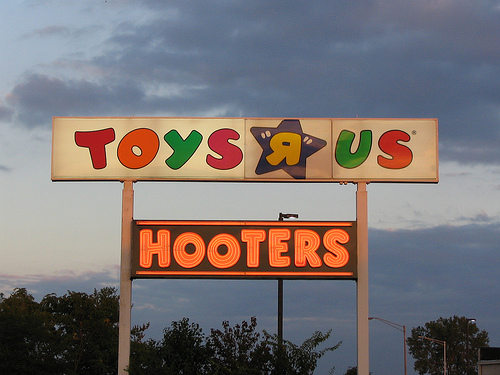Toys R Us Bankruptcy News Update
“With its bankruptcy filing late Monday, Toys R Us bought itself $3.1 billion in new financing that will allow it to stock and operate all of its stores through the crucial holiday season. But after the holidays are over, store closings are inevitable, bankruptcy experts say.
The company said it is “currently performing a detailed review of their real estate portfolio” and is identifying poorly performing stores and locations where the rents are too high in order to reduce the retail square footage.”
By last week, nearly 40% of the company’s toy vendors had refused to ship merchandise without cash on delivery, cash in advance, or in some cases, Brandon said, payment of all outstanding bills. Those actions, he said, left the company with no option but to seek bankruptcy protection.
… Mattel is the largest non-bank creditor listed by Toys R Us in court documents. It is owed $135.6 million by Toys.”

While in 2000, Toys ‘R’ Us represented 22% of Mattel’s $4.7 billion in sales and 13% of Hasbro’s $3.8 billion in sales, by 2016, toys shown at Toys ‘R’ Us represented about 11% of Mattel’s $5.5 billion sales and 9% of Hasbro’s $5 billion, according to Morningstar.
In recent years, the two toymakers have instead partnered increasingly with Target and Walmart as Toys ‘R’ Us’ ability to successfully sell those toys appeared to have stalled. Wal-Mart is now Mattel’s and Hasbro’s largest customer, while Target is the third largest for both, just behind Toys ‘R’ Us.
For those who like the deep dive … Bloomberg ...
“Goldman Sachs Group Inc. could rack up some quick gains from Toys “R” Us Inc.’s rapid unraveling.
“Toys R Us plans to use its bankruptcy filing as a way to reemerge on the cutting edge of the retail world, closing underperforming stores and transforming others into “interactive spaces” to thrill both adult and pint-sized customers.
The big-box retailer did not specify how many of its 1,600 stores it plans to shutter but acknowledged in a court filing Tuesday that “leases are a substantial burden” on its finances. The company also hopes to renegotiate some leases.”








In the 1980s I worked on the construction of several new Mervyn’s Department stores. These were all attached to brand new indoor shopping malls. I was surprised to learn that not only didn’t Mervyn’s have to pay for the land or the building construction, but that as anchor tenants they did not have pay rent either.
The mall developers would make their money on the rent charged to all the intermediate stores in the mall plus a share of their sales. The anchors (SEARS, Mervyns, Macy’s, etc.) were there rent free to draw in traffic to the mall.
Any number of these big box anchors could not survive on their own retail sales, even rent free. Mervyn’s went bankrupt in 2008.
“The big-box retailer…acknowledged… that “leases are a substantial burden”.
Almost 20 years ago I entered the employee side of retail, at Kmart-as they were upgrading their stores to “Big K” and even “Super” Kmarts. This was just a few short years before their first round of bankruptcies.
Young but savvy, I was surprised then when I learned from a manager that storefronts did not OWN, rather they leased the buildings and land they sat upon. Seemed foolish to me then why a multi-billion dollar company would not just outright own their buildings and land for a one time $3-$5 million purchase/investment (and thats probably quite a bit generous, as many of the stores had already been established for 15-20yrs-when land and construction were considerably cheaper, circa 1970s-80’s)
In the late 90s, with a smallish store that generated revenue of about $2.1M and profits of just about 1/4 to 1/3 of that, it would have taken just 5-10 years to pay off a loan that covered the purchase of land and the building itself, thusly eliminating one of the biggest expenses a “Big box” faces. A small price to pay over a few years rather than a constant pain in the….
Still today, I wonder why companies did not do this. Of course today, with the impact of e-commerce on brick and mortar sales, it no longer makes much sense to make such a huge investment with real estate, when their is future is not so much guaranteed.
Recently watched 2016’s “the Founder” with Michael Keaton. It’s a movie about how a struggling gimmick salesman named Ray Kroc stumbled upon a great restaurant and business model ran by two brothers in California. Kroc turned the single business into a worldwide empire of many but at one point faced the very same problems; profit and real estate. He learned though, that once he controlled the real estate, he would allow McDonald’s to not only survive, but thrive! Of course, I’d be a bit foolish if I totally ignored the franchise-franchisee relationship that played a role in the success of McD’s but after watching the movie I really couldn’t help but wonder if the same type of business model would have allowed businesses like these to also survive and thrive. Not franchising so much, but as far as real estate and land-holding…
I am no businessman, nor am I an expert but this all just seemed like common sense to me. Sometimes common sense, just isn’t though. Am I missing something? I welcome any critiques to my interpretation of this business model as an opportunity to learn-just please be respectful. I might be ignorant, but I’m not stupid.
Cheers!
The trick is, the investors who own the companies, ALSO often own the land holding companies as two separate entities. That way you can milk money out of the company (storefront) itself through leases, and the company that owns the land. When the time comes, if the land becomes valuable enough, you ditch the storefront, and sell the land.
Walmart has in fact, I think, two different companies that own the land, not just one. K-Mart has one as well, Pace Properties.
It’s all about squeezing every last penny out of the asset, then ditching it when it is either dead or too debt ridden to continue in business.